1910s FN Fabrique Nationale Shaft-drive 24″ Gent’s Bicycle (Belgian)

Frame number 13270

An FN Shaftdrive is an historic machine, as FN influenced the other early adopters of chainless bicycles, such as Pope Columbia (in the USA) and Metropole (in France). FN produced their first shaftdrive bicycle (also known as the Chainless or, in French, Acatene) in 1898.

On a practical level, the disadvantages of a shaft-drive may outweigh its advantages. Replacing a chain may be messy, but could be done easily enough by the rider; while greasing up a shaft-drive is easy enough, further servicing tasks require basic mechanical skills. Shaft-drive cycles were also more expensive.
The profile of a 100-year-old chainless bicycle is certainly pleasing on the eye. But chain-driven bicycles won the day, and early chainless bikes are now rare and very collectable.

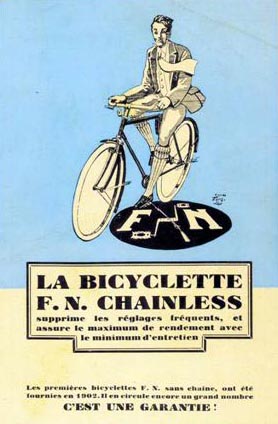


*************************
BRIEF HISTORY of FN HERSTAL
Fabrique National d’Armee de Guerre
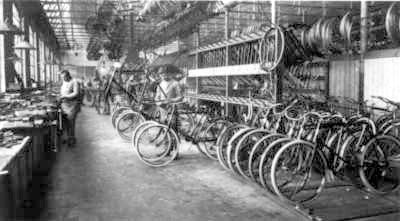
Weapons manufacturing in the Belgian city of Liège began as early as the 16th century. By the second half of the nineteenth century, the city featured a number of prominent arms manufacturers. In 1886, a group of manufacturers, including Ancion, Dumoulin Frères, Dresse-Laloux & Cie., J. Hanssen, and Pirlot-Frésart joined together to form an association, Les Fabricants d’Armes Réunis (United Arms Manufacturers).
An order from the Belgian Army in 1887 for 150,000 repeating rifles encouraged Les Fabricants d’Armes Réunis to begin planning a new, large scale factory, and in 1888 the group created a new company, Fabrique Nationale d’Armes de Guerre. The new factory was built in Herstal, and in 1889 the company launched production of the Belgian army order, producing Mauser-designed rifles under license. Mauser, based in Germany, then bought up the company from its founders.
At the completion of that contract, the Belgian army returned to the company, later to become known as FN Herstal, with an order for 30 million rounds for the Mauser rifles. FN Herstal promptly set up a dedicated munitions factory next to its rifle production site in 1891.

FN Herstal soon expanded its production to include civilian arms, especially hunting rifles. By the mid-1890s, the company began seeking other production areas, and in 1896 the company launched production of its own line of bicycles, including its own “acatene,” or chainless, shaft-driven bicycle designs. The company would remain a popular producer of bicycles for some 30 years.
From bicycles, FN Herstal entered the young automotive market, producing its first car in 1900 and its first motorcycle two years later. FN also provided proprietary engines for other companies. Vindec was one of several companies using FN engines in the early days. Below you can see an advert from The Motor, 25th March 1903, illustrating a Whippet with an FN engine. The 2-speed gear is not attached to the motor but to the pedalling gear of the bicycle. (Picture and info thanks to Leon Mitchell http://users.senet.com.au/~mitchell/index.htm).
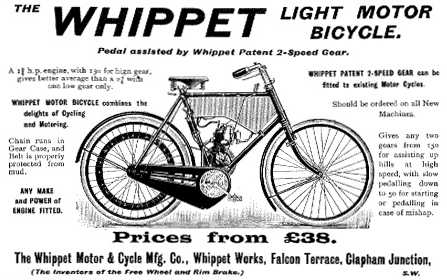
While the company stopped producing cars in 1937, it continued to build motorcycles into the 1960s. In addition, FN Herstal became a prominent truck manufacturer, with production running from 1930 to 1966, and also built trolleys between 1932 and 1955.

Closer to its core weapons production was the manufacturing of military vehicles, and activity in this area continued until the early 1980s. Its diversified product line notwithstanding, FN Herstal achieved its greatest renown as a maker of small arms.

According to the advert below, from Cycling magazine of 20th November, 1919, the address of F.N. (England) Ltd was Kimberley Rd, Willesden Lane, London NW6.

But my 1912 Cycling magazine ‘show issue’ mentions their address as being 106 Great Portland St, London W:
“These makers, who have specialized in the shaft-driven motorcycle, show a very attractive pedal cycle with this form of power transmission. Although only a sideline in the F.N business, these chainless bicycles are so popular on the Continent that the factory possesses facilities for a 50,000 output annually. The machine shown is an entirely new model.” (Sadly, no illustration provided).
*************************
The Age of this FN?
I don’t know its age. But from its design it appears to me to be an early example. Cycling Magazine states a production ability of 50,000 p.a in the 1912 article above. That seems fanciful in my opinion for a chainless model, given that it would have been an expensive bicycle to produce and sell. I would guess at an average of 1,000 per year.
Early FN motorcycles were bicycles with engine attached. You can see from the chart below the build-up of lightweight model production to 1914, with optimum output between 1903 and 1909. Production is certainly constant up to WW1. Assuming shaft-drive bicycle frame numbering ran in sequence, and that they manufactured 1,000 a year from the first in 1898, the frame number of this bike – 13270 – would make it around 1911.
1° Machines légères or Light weights.
1902 from n° 5000 to 5999
1903 from n° 6000 to 9999
1904-06 from n° 10.000 to 14.999
1907-09 from n° 20.000 to 24.999
1909-10 from n° 30.000 to 31.999
1910-11 from n° 32.000 to 34.999
1912-13 from n° 40.000 to 41.999
1913-14 from n° 42.000 to 45.830
Above chart thanks to Jacques Maertens’ excellent FN website – http://users.telenet.be/FN.oldtimers/index.htm

This FN Acatene is in good working order. The shaft-drive mechanism has been dismantled, cleaned, greased up and re-assembled. It rides well.

It’s clean lines are helped by the fact that there’s only one brake – like most European bikes of its era, that’s a coaster brake.

I think it was probably restored some time in the distant past.
It has a 24″ frame. There’s a step on the rear spindle if you need help jumping on. I’m 5′ 8″ and I can mount over the crossbar and ride it easily enough once I’ve inched myself onto the saddle.

It has a good-looking period saddle, of European manufacture and similar in style and construction to the saddles of pre-WW1 FN motorcycles.

Though it has a distinctive logo, I can’t make out the name, except for its model number of 50B.
There’s a dent in the frame just forward of the pedals, as you can see in the picture below. Overall the bike is tidy and presentable.

The rear wheel was buckled when I bought it. So we’ve replaced it with a new rim (below). The original rim is still available.
The rear hub does not have a manufacturer’s name.

I rode it along the seafront during recent storms.

**********************
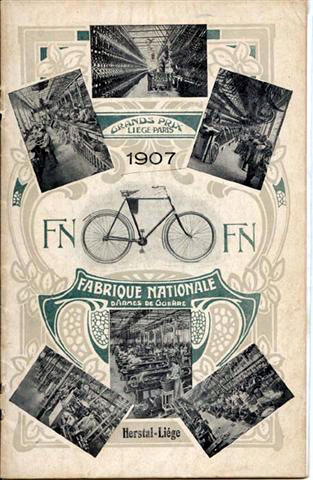
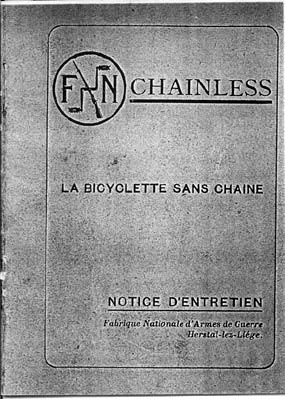
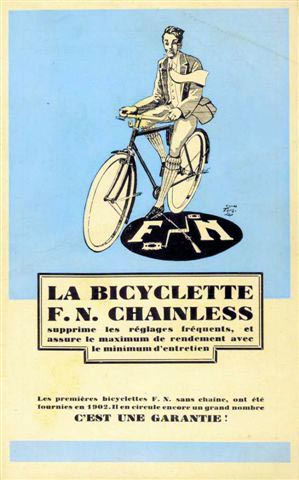
These brochures with thanks again to the excellent Belgian FN Motorcycle website –
http://users.telenet.be/FN.oldtimers/index.htm
**********************

***************
The FN is now sold. When I dismantled it for boxing I took a couple pictures of the shaft in case you wanted to see what they look like inside.
This bicycle has now been sold





You must be logged in to post a comment.